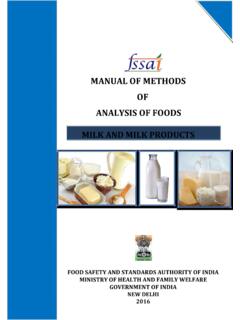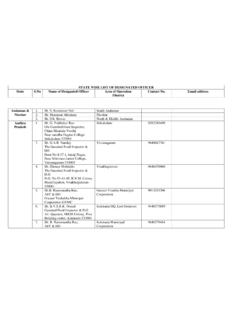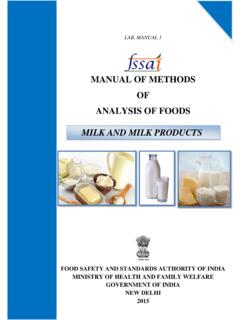Transcription of MANUAL ON METHOD OF MICROBIOLOGICAL TESTING …
1 MICROBIOLOGY OF FOODS 2016 MANUAL ON METHOD OF MICROBIOLOGICAL TESTING TABLE OF CONTENTS S. No. Title Page No. Chapter 1: MICROBIOLOGICAL Methods 1. Aerobic Mesophilic Plate count/Total Plate Count 1 2. Determination of Bacillus cereus in foods and beverages or Determination of aerobic Mesophilic spore formers 6 3. detection and Determination of Anaerobic Mesophilic Spore Formers in Foods (Clostridium perfringens) 11 4. detection and Determination of Coliforms, and in Foods and Beverages 14 5. Direct Microscopic Count for Sauces, Tomato Puree and Pastes 20 6. Fermentation Test (Incubation test) 25 7. detection and Confirmation of salmonella species in Foods 28 8. detection and Confirmation of Shigella species in Foods 36 9. detection , Determination and Confirmation of Staphylococcus aureus in Foods 39 10. detection and Confirmation of Vibrio cholera in Foods 43 11. detection and Confirmation of Vibrio parahaemolyticus in Foods 46 12.
2 Estimation of Yeast and Mould in foods and beverages 50 13. detection and Confirmation of Listeria monocytogenes in Foods 52 14. Isolation, Identification and confirmation of Campylobacter jejuni 59 15. Isolation, Identification and confirmation 70 16. Chapter 2: Culture Media 78 17. Chapter 3: Equipment, Materials and Glassware 123 18. Chapter 4: Biochemical Tests 125 Note: The test methods given in the manuals are validated/ standardized test methods. However, it would be the responsibility of the respective TESTING laboratory to confirm that the above methods are validated in its laboratory and gives proper result in their laboratory. MICROBIOLOGY OF FOODS 2016 1 MICROBIOLOGICAL METHODS FOR ANALYSIS OF FOODS, BEVERAGES AND ADJUNCTS 1. 1 Aerobic Mesophilic Plate count Indicates microbial counts for quality assessment of foods Equipment: Refer to Chapter 3 (Equipment, Materials & Glassware).
3 Medium: (i) Plate count agar; (ii) Peptone water , (iii) (Chapter 2 for composition of medium) Procedure: Preparation of food homogenate Make a 1:10 dilution of the well mixed sample, by aseptically transferring sample to the desired volume of diluent. Measure non-viscous liquid samples ( , viscosity not greater than milk) volumetrically and mix thoroughly with the appropriate volume of diluent (11 mL into 99 mL, or 10 mL into 90 mL or 50mL into 450 mL). Weigh viscous liquid sample and mix thoroughly with the appropriate volume of diluent (11 + into 99mL; 10+ into 90mL or 50+ into 450mL). Weigh as required of solid or semi-solid sample into a sterile blender jar or into a stomacher bag. Add 450 mL of diluents. Blend for 2 minutes at low speed (approximately 8000 rpm) or mix in the Stomacher for 30-60 seconds. Powdered samples may be weighed and MICROBIOLOGY OF FOODS 2016 2 directly mixed with the diluent.
4 Shake vigorously (50 times through 30 cm arc). In most of the food samples particulate matter floats in the dilution water. In such cases allow the particles to settle for two to three minutes and then draw the diluent from that portion of dilution where food particles are minimum and proceed. Dilution: If the count is expected to be more than x103 per mL or gm, prepare decimal dilutions as follows. Shake each dilution 25 times in 30cm arc. For each dilution use fresh sterile pipette. Alternately use auto pipette. Pipette 1 mL of food homogenate into a tube containing 9mL of the diluent. From the first dilution transfer 1mL to second dilution tube containing 9mL of the diluents. Cyclomixer can also be used. Repeat using a third, fourth or more tubes until the desired dilution is obtained. Pour plating: Label all petriplates with the sample number, dilution, date and any other desired information.
5 Pipette 1mL of the food homogenate and of such dilutions which have been selected for plating into a petri dish in duplicate. Pour into each petri dish 10 to 12mL of the molten PCA (cooled to 42-45 C) within 15 min from the time of preparation of original dilution. Mix the media and dilutions by swirling gently clockwise, anti-clockwise, to and fro thrice and taking care that the contents do not touch the lid. Allow to set. MICROBIOLOGY OF FOODS 2016 3 Incubation: Incubate the prepared dishes, inverted at 35oC +2 C for 48hours. (or the desired temperature as per food regulation in case of packaged drinking water). Counting Colonies: Following incubation count all colonies on dishes containing 30-300 colonies and record the results per dilution counted. Calculation In dishes which contain 30-300 (95 to 100 mm size of petriplate) or 20 to 200 (90 to 95mm size of petriplate) colonies count the actual number in both plates of a dilution and as per the formula given below, when the colony count is 100 or above C N= (N1+ ) D C is the sum of colonies counted on all the dishes retained N1 is the no.
6 Of dishes retained in the first dilution N2 is the no of dishes retained in the second dilution D is the dilution factor corresponding to first dilution At the first dilution retained (10-2):165 & 218 colonies At the second dilution retained (10-3) 15 & 24 N= 165+218+15+24 = 422 = 19182 [2 + ( ) x 10x-2] MICROBIOLOGY OF FOODS 2016 4 Rounding the result to first two digits gives 19000 or x 104 CFU/g or mL. C N= V x x d C is the sum of colonies counted on all the dishes retained V is the volume of inoculum in each dish, in milliliters. d is the dilution corresponding to the first dilution retained [d = 1 when the undiluted liquid product (test sample) is retained]. At the first dilution retained (10-2):168 colonies At the second dilution retained (10-3) 14 colonies N= 168+14 = 180 = 16545 1 x x 10-2 Rounding the result to first two digits gives 17000 or x 104 CFU/g or mL.
7 Expression of Result Aerobic (Mesophilic) Plate Count = 19000 CFU/g or CFU/g or ml Aerobic (Mesophilic) Plate Count = 17000 CFU/g or CFU/g or mL or MICROBIOLOGY OF FOODS 2016 5 If plates from all dilutions have no colonies and inhibitory substances have not been detected, the result is expressed as less than 1 x 101 CFU per g or mL. If plates from the lowest dilutions contain less than 30 colonies, record the actual number and calculate as above but express results as CFU per g or mL. Note: - This METHOD , as all other methods, has some limitations. Microbial cells often occur as clumps, clusters, chains or pairs in foods, and may not be well distributed irrespective of the mixing and dilution of the sample. Moreover the single agar medium used, the conditions of incubation, aeration etc., are not conducive to the growth of various populations of bacteria that may be present in a food sample.
8 For statistical reasons alone, in 95% of cases the confidence limits of this test vary from 12% to 37%. In practice even greater variation may be found especially among results obtained by different microbiologists. (Corvell and Morsettle, J. Sci. Fd. Agric., 1969, vol. 20 p 573) MICROBIOLOGY OF FOODS 2016 6 References: 1. Official Methods of Analysis of AOAC International (1995). 16th Edition. Edited by Patricia Cuniff. Published by AOAC International. Virginia. USA. Test 2. Compendium of Methods for the MICROBIOLOGICAL Examination of Foods. (1992) Carl Vanderzant and Don F. Splittstoesser Eds. Washington p. 75-87 3. Bacteriological Analytical MANUAL (1992) 6th Edn. Arlington, Association of Official Analytical Chemists for FDA, Washington, p. 17-21. 4. Microbiology of food and animal feeding stuffs General requirements and guidance for MICROBIOLOGICAL examinations - ISO 7218:2013 5.
9 Microbiology- General Guidance for the enumeration of Microorganisms-Colony count technique at 35 C (first revision) IS5402-2002, ISO4833:1991. Bureau of Indian Standards, Manak Bhavan, 9 Bhadur Shah Zafar Marg, New Delhi110002. 2. detection and Determination of Bacillus cereus in Foods, and Beverages or Determination of aerobic mesophillic spores in Foods and Beverages Equipment: Refer to Chapter 3 MICROBIOLOGY OF FOODS 2016 7 Culture media and reagents (i) Mannitol-egg yolk-polymyxin (MYP) agar (ii) Trypticase-soy-polymyxin broth (iii) Phenol red dextrose broth (iv) Nitrate broth (v) Nutrient agar slants and plates (vi) Nutrient agar with L-tyrosine (vii) Nutrient broth with lysozyme (viii) Modified Voges- Proskauer medium (VP) (ix) Motility medium (x) Nitrate test reagents (xi) Voges- Proskauer test reagents Procedure Preparation of food homogenate Prepare as directed in For aerobic spore count pasteurize 10-1 dilution of sample at 80 C for 10 minutes and proceed as given below: Dilution Prepare decimal dilutions by pouring 1mL in 9 mL of dilution water.
10 Most Probable Number METHOD This procedure is suitable for the examination of foods which are expected to contain fewer than 1000 B. cereus per gm. MICROBIOLOGY OF FOODS 2016 8 i. Inoculate each of three tubes of trypticase-soy-polymyxin broth with 1 mL food homogenate and its dilutions. ii. Incubate at 30 C for 48 hours. iii. Examine for dense growth typical of B. cereus iv. Vortex-mix and using a 3mm loop transfer one loopful from each growth positive tube to dried MYP medium plates. Streak to obtain isolated colonies. v. Incubate at 30 C for 48 hours vi. Pick one or more eosin pink (mannitol fermentation positive) colonies surrounded by precipitate zone (due to lecithinase activity) from each plate and transfer to nutrient agar slants for confirmation tests. vii. The confirmed B. cereus count is determined using the MPN Table of Test No. 10 for coliform count.













